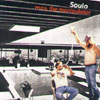 Thelast few years have been a pretty interesting time for pop andelectronic music. As the technological side of music has gained morecredibility as an art form, it's taken on some more "traditional"facets which have spun off a bunch of interesting hybrids that continueto collide and fuse amongst themselves. Man, the Manipulator,the second release from the Chicago art school duo of Shawn King andNate Flanigan as Soulo, is a prime example of how mixing laid back,orchestrated pop songwriting with various areas of electronic music canremain focused without leaning too heavily in one general direction andstill be very "musical" in the traditional sense. The warmth ofacoustic guitar and Theremin-like whistling keyboard on the intro of"How Do You Feel?" remains throughout the addition of relaxed machinebeats, bass end and the near squelch of keyboards, even when it dropsout for some simple, yet effective organ licks. The ethereal "Emotions,Can You Trust Them?" builds from the murkiness of synth ambience tosoft vocals and pitch bending bass peppered with piano, held togetherwith a rhythm so laid-back that you could drive a truck between thebeats. "Born Female" blurs backwards guitar and violin into an almostcall and response melodic line over Rhodes piano, thickeningelectro-bass and crisp machine beats for a sweetness that's summed upin all of two minutes. Rounding out the disc's twelve tracks, "ThePeter Principle" opens with a scratchy punch-in-the-gut rhythm,electro-chaos, feedback and heavy metal power chords that drag it in araunchy direction only to subside in intensity once upright bass,trumpet, violin, clarinet and banjo (yes, banjo) come quickly to theforefront. It's quirky, yet makes perfect sense and totally works. Atjust over thirty-eight minutes, the bulk of the disc's tracks are inand around the three minute mark, which tends to be a bit brief forsome ideas to play out and be embellished. By the same token, Soulo'ssparingly used clever and popish hooks are more effective in thismanner than listening to them repeat a thousand times so as to addanother synth module.
Thelast few years have been a pretty interesting time for pop andelectronic music. As the technological side of music has gained morecredibility as an art form, it's taken on some more "traditional"facets which have spun off a bunch of interesting hybrids that continueto collide and fuse amongst themselves. Man, the Manipulator,the second release from the Chicago art school duo of Shawn King andNate Flanigan as Soulo, is a prime example of how mixing laid back,orchestrated pop songwriting with various areas of electronic music canremain focused without leaning too heavily in one general direction andstill be very "musical" in the traditional sense. The warmth ofacoustic guitar and Theremin-like whistling keyboard on the intro of"How Do You Feel?" remains throughout the addition of relaxed machinebeats, bass end and the near squelch of keyboards, even when it dropsout for some simple, yet effective organ licks. The ethereal "Emotions,Can You Trust Them?" builds from the murkiness of synth ambience tosoft vocals and pitch bending bass peppered with piano, held togetherwith a rhythm so laid-back that you could drive a truck between thebeats. "Born Female" blurs backwards guitar and violin into an almostcall and response melodic line over Rhodes piano, thickeningelectro-bass and crisp machine beats for a sweetness that's summed upin all of two minutes. Rounding out the disc's twelve tracks, "ThePeter Principle" opens with a scratchy punch-in-the-gut rhythm,electro-chaos, feedback and heavy metal power chords that drag it in araunchy direction only to subside in intensity once upright bass,trumpet, violin, clarinet and banjo (yes, banjo) come quickly to theforefront. It's quirky, yet makes perfect sense and totally works. Atjust over thirty-eight minutes, the bulk of the disc's tracks are inand around the three minute mark, which tends to be a bit brief forsome ideas to play out and be embellished. By the same token, Soulo'ssparingly used clever and popish hooks are more effective in thismanner than listening to them repeat a thousand times so as to addanother synth module. Thelast few years have been a pretty interesting time for pop andelectronic music. As the technological side of music has gained morecredibility as an art form, it's taken on some more "traditional"facets which have spun off a bunch of interesting hybrids that continueto collide and fuse amongst themselves. Man, the Manipulator,the second release from the Chicago art school duo of Shawn King andNate Flanigan as Soulo, is a prime example of how mixing laid back,orchestrated pop songwriting with various areas of electronic music canremain focused without leaning too heavily in one general direction andstill be very "musical" in the traditional sense. The warmth ofacoustic guitar and Theremin-like whistling keyboard on the intro of"How Do You Feel?" remains throughout the addition of relaxed machinebeats, bass end and the near squelch of keyboards, even when it dropsout for some simple, yet effective organ licks. The ethereal "Emotions,Can You Trust Them?" builds from the murkiness of synth ambience tosoft vocals and pitch bending bass peppered with piano, held togetherwith a rhythm so laid-back that you could drive a truck between thebeats. "Born Female" blurs backwards guitar and violin into an almostcall and response melodic line over Rhodes piano, thickeningelectro-bass and crisp machine beats for a sweetness that's summed upin all of two minutes. Rounding out the disc's twelve tracks, "ThePeter Principle" opens with a scratchy punch-in-the-gut rhythm,electro-chaos, feedback and heavy metal power chords that drag it in araunchy direction only to subside in intensity once upright bass,trumpet, violin, clarinet and banjo (yes, banjo) come quickly to theforefront. It's quirky, yet makes perfect sense and totally works. Atjust over thirty-eight minutes, the bulk of the disc's tracks are inand around the three minute mark, which tends to be a bit brief forsome ideas to play out and be embellished. By the same token, Soulo'ssparingly used clever and popish hooks are more effective in thismanner than listening to them repeat a thousand times so as to addanother synth module.
Thelast few years have been a pretty interesting time for pop andelectronic music. As the technological side of music has gained morecredibility as an art form, it's taken on some more "traditional"facets which have spun off a bunch of interesting hybrids that continueto collide and fuse amongst themselves. Man, the Manipulator,the second release from the Chicago art school duo of Shawn King andNate Flanigan as Soulo, is a prime example of how mixing laid back,orchestrated pop songwriting with various areas of electronic music canremain focused without leaning too heavily in one general direction andstill be very "musical" in the traditional sense. The warmth ofacoustic guitar and Theremin-like whistling keyboard on the intro of"How Do You Feel?" remains throughout the addition of relaxed machinebeats, bass end and the near squelch of keyboards, even when it dropsout for some simple, yet effective organ licks. The ethereal "Emotions,Can You Trust Them?" builds from the murkiness of synth ambience tosoft vocals and pitch bending bass peppered with piano, held togetherwith a rhythm so laid-back that you could drive a truck between thebeats. "Born Female" blurs backwards guitar and violin into an almostcall and response melodic line over Rhodes piano, thickeningelectro-bass and crisp machine beats for a sweetness that's summed upin all of two minutes. Rounding out the disc's twelve tracks, "ThePeter Principle" opens with a scratchy punch-in-the-gut rhythm,electro-chaos, feedback and heavy metal power chords that drag it in araunchy direction only to subside in intensity once upright bass,trumpet, violin, clarinet and banjo (yes, banjo) come quickly to theforefront. It's quirky, yet makes perfect sense and totally works. Atjust over thirty-eight minutes, the bulk of the disc's tracks are inand around the three minute mark, which tends to be a bit brief forsome ideas to play out and be embellished. By the same token, Soulo'ssparingly used clever and popish hooks are more effective in thismanner than listening to them repeat a thousand times so as to addanother synth module. Scott Sinfield and Jon Attwood (or Portal and Yellow6) met when Attwooddonated guitar for a track on Portal's debut album. Shortly thereafter,the pair began making music together on a limited basis. They sharedthe stage on tour, backing each other for their respective projects,and for a series of split EPs in 2000, they covered each other's songs.Finally, on the debut release from their own label, Make Mine Music,the two properly collaborate. Both Portal and Yellow6 get two tracks apiece on this split, as well as the four tracks they perform together,and in this case the whole truly is greater than the sum of its parts.I'll go as far as to say the two gentlemen should start a new bandtogether, bring vocalist Rachel Hughes along for the ride, and leavetheir separate discographies in the dust. Portal starts off the releasewith a cold air, a temperature setting that remains for half therelease. Hughes, who has worked with Sinfield since his debut, soundsdetached and aloof, as she sings about her misconceptions and seeminglyundying hope. Then, on "The First Breath of Winter," the chill settlesin, as breath turns to mist, and the programmed beat, keyboards, andechoed guitar emit languish in their confines. The track threatens togo somewhere, but ultimately stays static, yet again reinforcing adetachment and brushing off. Yellow6 seems to take this frozen energyat face value, presenting "Threefold," a track that starts with simpleguitar structures and a minimalist beat. None of this should beperceived as negative: the song is still enough to make the heartpatter, albeit at a slower pace. At about the three minute mark,though, Yellow6 returns to form, opening the door for virulentdistortion that spills everywhere. This is not warmth that lasts,however, as the track ends on the same cold note on which it began."The Sinking Sun" is also appropriately titled, as though the lunarteam is stuck, and they watch the daylight fade, unable to stop it orsave themselves. Even in the clutches of such a cold death, the moonseems to shift its rotation on the next track, the first of thecontributions to feature both artists. Suddenly, there is hope,possibility, life, and a hint of meaning to all of existence. It's thatpowerful, that moving, and it lasts for nigh on twenty-four minutes.Sometimes, the cold fights to return, such as on "#5," but it isn'tstrong enough to cause the ice age it threatens. The fire stays, evenbuilds somewhat glacially on "#3;" and although both Sinfield andAttwood shouldn't quit their day jobs, they should make a record likethis together and share more of this ambient wonder with the world.Make Mine Music also shows potential as a quite progressive label, withPortal, Yellow6, and Epic 45 full-lengths already released orforthcoming.
Scott Sinfield and Jon Attwood (or Portal and Yellow6) met when Attwooddonated guitar for a track on Portal's debut album. Shortly thereafter,the pair began making music together on a limited basis. They sharedthe stage on tour, backing each other for their respective projects,and for a series of split EPs in 2000, they covered each other's songs.Finally, on the debut release from their own label, Make Mine Music,the two properly collaborate. Both Portal and Yellow6 get two tracks apiece on this split, as well as the four tracks they perform together,and in this case the whole truly is greater than the sum of its parts.I'll go as far as to say the two gentlemen should start a new bandtogether, bring vocalist Rachel Hughes along for the ride, and leavetheir separate discographies in the dust. Portal starts off the releasewith a cold air, a temperature setting that remains for half therelease. Hughes, who has worked with Sinfield since his debut, soundsdetached and aloof, as she sings about her misconceptions and seeminglyundying hope. Then, on "The First Breath of Winter," the chill settlesin, as breath turns to mist, and the programmed beat, keyboards, andechoed guitar emit languish in their confines. The track threatens togo somewhere, but ultimately stays static, yet again reinforcing adetachment and brushing off. Yellow6 seems to take this frozen energyat face value, presenting "Threefold," a track that starts with simpleguitar structures and a minimalist beat. None of this should beperceived as negative: the song is still enough to make the heartpatter, albeit at a slower pace. At about the three minute mark,though, Yellow6 returns to form, opening the door for virulentdistortion that spills everywhere. This is not warmth that lasts,however, as the track ends on the same cold note on which it began."The Sinking Sun" is also appropriately titled, as though the lunarteam is stuck, and they watch the daylight fade, unable to stop it orsave themselves. Even in the clutches of such a cold death, the moonseems to shift its rotation on the next track, the first of thecontributions to feature both artists. Suddenly, there is hope,possibility, life, and a hint of meaning to all of existence. It's thatpowerful, that moving, and it lasts for nigh on twenty-four minutes.Sometimes, the cold fights to return, such as on "#5," but it isn'tstrong enough to cause the ice age it threatens. The fire stays, evenbuilds somewhat glacially on "#3;" and although both Sinfield andAttwood shouldn't quit their day jobs, they should make a record likethis together and share more of this ambient wonder with the world.Make Mine Music also shows potential as a quite progressive label, withPortal, Yellow6, and Epic 45 full-lengths already released orforthcoming.- Portal - Hold
- Yellow6 - The Sinking Sun
- Sinfield/Attwood - #2
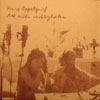 Completely out of the blue comes an extraordinary little CD, sopowerful in its minute way, hugely evocative and humane. The clues towhat's going on are in the photos—a living room recording set up withMr. Appelqvist marshalling apparently amateur singers. He plays thepiano and a few other things, talks to the singers and they sing. It isthe intimacy of it that is most compelling, so intense that it isalmost unbearable but beautiful and joyous in such an honest and directway that is truly unique. Only a few of the Songs in the Key of Zcome close and none have this fragility or fluidity. Zenna and Marieare the two little girls on the first track, they sing a song inSwedish chat and then "Be What You Wanna Be" in English. They don'tseem to know all the words, loose their way, mumble some lines but nomatter—they come back to the chorus with enthusiasm and unaffectedpositivity that only the Langly Schools Music Project can touch.Appelqvist's lively playing is deft and idiosyncratic with a delightfullight touch that adds much musicality without moving beyond the role ofaccompaniment. The directness and total absence of artifice carriesover to the sound quality, which is simply brilliant. It puts you rightthere in that mundane living room with these wonderful people topositively eerie effect, as though you were invading someone's privacy.Xiang, more grown up and probably Chinese, sings on track two. Sheexpresses the self-consciousness that comes after childhood and beforeactual maturity. Ruth, older again, is soloist on track three. Hersong, "Geh aus, mein Herz," is given a strangely menacing backdrop witha few heavy guitar chords and ethereal flutes. She sings with theconfidence of someone who has been through motherhood and long sincesent her children off into the world. She seems to treat Appelqvist'sproject with the indulgence she would give to her grandchildren'santics. One could perhaps say that this disk is about language, how itaffects music, how song, intonation and melody adapt to it. The girlssound so different in English from Swedish, Xiang shows that the melodyof Chinese is inescapable, and Ruth's song in German shows thestrictness of that language and how uncomfortable it is with melody.Interesting as this thought may be, the real stuff here is in theemotion and how we lose so much of that with all the manufacturinginvolved in the other music we hear.
Completely out of the blue comes an extraordinary little CD, sopowerful in its minute way, hugely evocative and humane. The clues towhat's going on are in the photos—a living room recording set up withMr. Appelqvist marshalling apparently amateur singers. He plays thepiano and a few other things, talks to the singers and they sing. It isthe intimacy of it that is most compelling, so intense that it isalmost unbearable but beautiful and joyous in such an honest and directway that is truly unique. Only a few of the Songs in the Key of Zcome close and none have this fragility or fluidity. Zenna and Marieare the two little girls on the first track, they sing a song inSwedish chat and then "Be What You Wanna Be" in English. They don'tseem to know all the words, loose their way, mumble some lines but nomatter—they come back to the chorus with enthusiasm and unaffectedpositivity that only the Langly Schools Music Project can touch.Appelqvist's lively playing is deft and idiosyncratic with a delightfullight touch that adds much musicality without moving beyond the role ofaccompaniment. The directness and total absence of artifice carriesover to the sound quality, which is simply brilliant. It puts you rightthere in that mundane living room with these wonderful people topositively eerie effect, as though you were invading someone's privacy.Xiang, more grown up and probably Chinese, sings on track two. Sheexpresses the self-consciousness that comes after childhood and beforeactual maturity. Ruth, older again, is soloist on track three. Hersong, "Geh aus, mein Herz," is given a strangely menacing backdrop witha few heavy guitar chords and ethereal flutes. She sings with theconfidence of someone who has been through motherhood and long sincesent her children off into the world. She seems to treat Appelqvist'sproject with the indulgence she would give to her grandchildren'santics. One could perhaps say that this disk is about language, how itaffects music, how song, intonation and melody adapt to it. The girlssound so different in English from Swedish, Xiang shows that the melodyof Chinese is inescapable, and Ruth's song in German shows thestrictness of that language and how uncomfortable it is with melody.Interesting as this thought may be, the real stuff here is in theemotion and how we lose so much of that with all the manufacturinginvolved in the other music we hear.  After a series of EPs and singles, northern England's 2 By Bukowski have released their second full, experimenting with spare, atmospheric soundscapes and wild, jarring collisions of noise. On Drink From My Bastard Grail,they straddle the line of introspective ambient and volatilepsyche-rock, offering energizing slivers of each throughout the disc."Chopperfuck" begins with a filthy, snarling guitar riff over slow,crawling drumbeats and heavy, distorted chords that swirl like anintense storm. Suddenly a distant female voice pokes through and theclouds lift as a calm, meditative melody wisps along with it. Therespite is short-lived, and the track once again climbs upward in afrenzy of distorted squeals and groans. "Wild Manner" is a vicious,screaming assault of amplifier feedback, lurching along full of biliousthrust. It's a frenetic sound, yet one that is underpinned by a solid,restrained rhythm that keeps everything from flying out in everyconceivable direction a la Comets on Fire. Bukowski are a far moreprecise outfit than that. The energy can be felt bubbling beneaththere, but the control makes the track all the more tense and cohesive.A simple arrangement of piano triads leads "I Am Ready For Death inThis Dominion," coupled with synthesized strings to give the air of amournful funeral procession. Bukowski plays with standard, thoughtfulpieces as well, eschewing the noise for expansive compositions thatoperate through mood and texture rather than gut reactions. "The LastAerie" and "Gate 3" both take the slow road, the latter using trebledchirps and gurgling effects to evoke a teeming brook and gusts out intoa pleasing pastoral wash. The movement between the louder and softertracks doesn't result in dissonance, but in fact highlights thestrengths of each in contrast. Just when 2 By Bukowski sounds as ifthey are going to pull apart and shatter, they slip in with a welcomeand rejuvenating break from the schizophrenia. An excess of either endof the spectrum would have made for a stale listen, but the group showsthat they can sound powerful and dynamic whether mired in sludgy rockor icy ambiance. 'Drink From My Bastard Grail' is soothing, enervating,pleasing, and provocative. With these tensions rubbing against oneanother, the friction they generate makes for an engaging listen.
After a series of EPs and singles, northern England's 2 By Bukowski have released their second full, experimenting with spare, atmospheric soundscapes and wild, jarring collisions of noise. On Drink From My Bastard Grail,they straddle the line of introspective ambient and volatilepsyche-rock, offering energizing slivers of each throughout the disc."Chopperfuck" begins with a filthy, snarling guitar riff over slow,crawling drumbeats and heavy, distorted chords that swirl like anintense storm. Suddenly a distant female voice pokes through and theclouds lift as a calm, meditative melody wisps along with it. Therespite is short-lived, and the track once again climbs upward in afrenzy of distorted squeals and groans. "Wild Manner" is a vicious,screaming assault of amplifier feedback, lurching along full of biliousthrust. It's a frenetic sound, yet one that is underpinned by a solid,restrained rhythm that keeps everything from flying out in everyconceivable direction a la Comets on Fire. Bukowski are a far moreprecise outfit than that. The energy can be felt bubbling beneaththere, but the control makes the track all the more tense and cohesive.A simple arrangement of piano triads leads "I Am Ready For Death inThis Dominion," coupled with synthesized strings to give the air of amournful funeral procession. Bukowski plays with standard, thoughtfulpieces as well, eschewing the noise for expansive compositions thatoperate through mood and texture rather than gut reactions. "The LastAerie" and "Gate 3" both take the slow road, the latter using trebledchirps and gurgling effects to evoke a teeming brook and gusts out intoa pleasing pastoral wash. The movement between the louder and softertracks doesn't result in dissonance, but in fact highlights thestrengths of each in contrast. Just when 2 By Bukowski sounds as ifthey are going to pull apart and shatter, they slip in with a welcomeand rejuvenating break from the schizophrenia. An excess of either endof the spectrum would have made for a stale listen, but the group showsthat they can sound powerful and dynamic whether mired in sludgy rockor icy ambiance. 'Drink From My Bastard Grail' is soothing, enervating,pleasing, and provocative. With these tensions rubbing against oneanother, the friction they generate makes for an engaging listen. 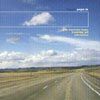 The third single Dave Pajo's series of audio tour diaries showcases hisinterpretation of a couple of covers and one original track; recordedin Bloomington and Chicago while on tour with his current day job,Zwan. Pajo's vocals and country-influenced guitar pickin' on thetraditional "Wild Mountain Thyme" convey the tune's original spirit.Background vocals and strings from collaborators Molly Kien and MaggiePolk make this track all the more authentic. My current favoritehurtin' tune would be Pajo's cover of Little Feat's "Truckstop Girl"with its jangly capo'ed acoustic guitar that, while beautifully played,brings a sadness along with vocals that sing of the end of a loveaffair that results in tragedy. Although the overdubbed electricguitars that take the tune out are fairly simple, their tone and timingare very powerful in context. The original "Who Knows" has Pajohandling the duties of drummer and bass player along with hismulti-tracked vocals and guitars on a relaxed tune whose interestingcountry-tinged chord changes and lyrics feel very comfortable. As thesesingles are being released, I've been wondering if any of the materialmight surface on the next full-length Papa M release. As I'd mentionedin a prior review, there's a certain charm to hearing these tunesstripped down as they are. If this is what Mr. Pajo has been up towhile he's busy on the road, the results from being in a more relaxedstudio environment should be all the more exciting.
The third single Dave Pajo's series of audio tour diaries showcases hisinterpretation of a couple of covers and one original track; recordedin Bloomington and Chicago while on tour with his current day job,Zwan. Pajo's vocals and country-influenced guitar pickin' on thetraditional "Wild Mountain Thyme" convey the tune's original spirit.Background vocals and strings from collaborators Molly Kien and MaggiePolk make this track all the more authentic. My current favoritehurtin' tune would be Pajo's cover of Little Feat's "Truckstop Girl"with its jangly capo'ed acoustic guitar that, while beautifully played,brings a sadness along with vocals that sing of the end of a loveaffair that results in tragedy. Although the overdubbed electricguitars that take the tune out are fairly simple, their tone and timingare very powerful in context. The original "Who Knows" has Pajohandling the duties of drummer and bass player along with hismulti-tracked vocals and guitars on a relaxed tune whose interestingcountry-tinged chord changes and lyrics feel very comfortable. As thesesingles are being released, I've been wondering if any of the materialmight surface on the next full-length Papa M release. As I'd mentionedin a prior review, there's a certain charm to hearing these tunesstripped down as they are. If this is what Mr. Pajo has been up towhile he's busy on the road, the results from being in a more relaxedstudio environment should be all the more exciting.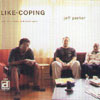 For the first release under his own name, guitarist Jeff Parker(Tortoise/Isotope 217) presents a disc of fairly straight-ahead jazzcompositions in a trio setting featuring longtime associates and fellowChicago Undergrounders Chris Lopes on upright bass and Chad Taylor ondrums. Although Parker's playing is the main focal point with thisformat, the group's well-crafted compositions and support convey anhonesty of a collective recording that just happens to feature theguitar, moreso than a soloist with a backing group. A few free-jazzfreakouts are also included for good measure. Taylor's heartfeltcomposition, "Miriam," opens the disc as a brushed waltz of warm chordchanges that briefly sneak into double time throughout subtle guitarsoloing. The disc's uptempo title track, penned by Lopes, features somecool vamping sections at the chorus' turnaround that solidify thestructure and give a strong reference point during each player's solo.Named for his daughter, Parker's "Days Fly By (with Ruby)" moves froman oom-pah styled unison guitar and bass intro over Taylor's busy brushsoloing to finger snapping swing for some tasteful playing on anoverall great composition. The only hint of structure on thefree-spirited "Omega Sci Fi" are the blasts of walking bass lines thatplay against bombastic drums, splintered cymbals and scraping guitarfor four minutes of busy instrumental dialogue that chases down thenext line to be stated. Fans of Parker's work that have come to expecta certain style of playing and tone with his above mentioned maingroups, along with other projects such as Toe 2000 and Tricolor shouldbe pleasantly surprised with this album. A more traditional style ofwriting and playing that hadn't been as evident before shinesthroughout the recording and shows the vast talent of a great player.
For the first release under his own name, guitarist Jeff Parker(Tortoise/Isotope 217) presents a disc of fairly straight-ahead jazzcompositions in a trio setting featuring longtime associates and fellowChicago Undergrounders Chris Lopes on upright bass and Chad Taylor ondrums. Although Parker's playing is the main focal point with thisformat, the group's well-crafted compositions and support convey anhonesty of a collective recording that just happens to feature theguitar, moreso than a soloist with a backing group. A few free-jazzfreakouts are also included for good measure. Taylor's heartfeltcomposition, "Miriam," opens the disc as a brushed waltz of warm chordchanges that briefly sneak into double time throughout subtle guitarsoloing. The disc's uptempo title track, penned by Lopes, features somecool vamping sections at the chorus' turnaround that solidify thestructure and give a strong reference point during each player's solo.Named for his daughter, Parker's "Days Fly By (with Ruby)" moves froman oom-pah styled unison guitar and bass intro over Taylor's busy brushsoloing to finger snapping swing for some tasteful playing on anoverall great composition. The only hint of structure on thefree-spirited "Omega Sci Fi" are the blasts of walking bass lines thatplay against bombastic drums, splintered cymbals and scraping guitarfor four minutes of busy instrumental dialogue that chases down thenext line to be stated. Fans of Parker's work that have come to expecta certain style of playing and tone with his above mentioned maingroups, along with other projects such as Toe 2000 and Tricolor shouldbe pleasantly surprised with this album. A more traditional style ofwriting and playing that hadn't been as evident before shinesthroughout the recording and shows the vast talent of a great player.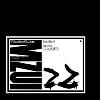 Back before the Internet and World Wide Web allowed music junkies to connect with others and trade secrets, fans of bands in areas of the world far outside the band's nucleus had to rely on sources like magazines and books for the best information they could get on a group. Despite being a project from former Wire members, the experimental music contained didn't make it a title which warranted an in-print status and copies worldwide were rather scarce. As a young Wire fan, it had been on my personal wish list for years. When I finally discovered it in 1998 as a used record for $30 my heart jumped. I finally found it!
Back before the Internet and World Wide Web allowed music junkies to connect with others and trade secrets, fans of bands in areas of the world far outside the band's nucleus had to rely on sources like magazines and books for the best information they could get on a group. Despite being a project from former Wire members, the experimental music contained didn't make it a title which warranted an in-print status and copies worldwide were rather scarce. As a young Wire fan, it had been on my personal wish list for years. When I finally discovered it in 1998 as a used record for $30 my heart jumped. I finally found it!
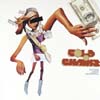 It's not surprising that the first full-length Gold Chains release isreceiving mixed reviews. Everybody's only used to hearing a GC productin shorter increments—and the reason why that works so perfectly isthat it's complimentary to the unique GC style. Topher LaFata, whobasically -is- Gold Chains is one mad talented motherfucker. His rap isdensely packed, rarely ever pausing to let the music to exist on itsown, while the music is so intricate and involved, changing stylesoften from bar to bar. By the second track he's gone from four on thefloor techno to swinging post-industrial, and nerdy glitch pop all in amatter of minutes. The swapping of styles continues for the rest of therelease, from parodies of big buck rap to jazzy interludes. Couple thiswith rare occurances of lyrical repetition or a "chorus," and tuning into the music demands complete and undivided attention. Only untilrepeated listens are instruments like live drums, piano, and guitarseven audible, since the subject matter of the rap is such an involvedfantasy world that it's hard to pay attention to everything else that'sgoing on. Thankfully lyrics were included this time around. Reading thelyrics without the music is also a fun exercise as they make greatjournal entries or stream of consciousness writing on their own. Topherloves to play with language, with a number of themes which seem toresurface. Themes about San Francisco, society, sex, drugs, money, and"warpping that Cali cooch in Prada" are amusing but crashing 11 songsof that in a row makes this album work best as a record to be paused inthe middle while the listener's got to get up off their ass and go flipit. In a bizarre way, it all makes sense that Topher is an oldindustrial fan, a former punk bass player, and allegedly an intensecomputer programmer. Gold Chains is almost like the prog-rock of modernelectronic laptop rap, as the music is so dense, academicallyflamboyant, technically nerdy, but superbly addictive after its hookshave sunk in. Some people claim that with an expensive video and theright promotion, this guy could be huge, but I think at this point hismusic is far more involved than the general public can handle. I lookforward to the "techno" album LaFata claims to be working on as even anold GC tune like "Burn Babylon" has the fabulous powers of sexy killerhooks. The question remains: if world domination is in the dreams ofGC, is he willing to dumb his music down for the masses? I sure as hellhope not.
It's not surprising that the first full-length Gold Chains release isreceiving mixed reviews. Everybody's only used to hearing a GC productin shorter increments—and the reason why that works so perfectly isthat it's complimentary to the unique GC style. Topher LaFata, whobasically -is- Gold Chains is one mad talented motherfucker. His rap isdensely packed, rarely ever pausing to let the music to exist on itsown, while the music is so intricate and involved, changing stylesoften from bar to bar. By the second track he's gone from four on thefloor techno to swinging post-industrial, and nerdy glitch pop all in amatter of minutes. The swapping of styles continues for the rest of therelease, from parodies of big buck rap to jazzy interludes. Couple thiswith rare occurances of lyrical repetition or a "chorus," and tuning into the music demands complete and undivided attention. Only untilrepeated listens are instruments like live drums, piano, and guitarseven audible, since the subject matter of the rap is such an involvedfantasy world that it's hard to pay attention to everything else that'sgoing on. Thankfully lyrics were included this time around. Reading thelyrics without the music is also a fun exercise as they make greatjournal entries or stream of consciousness writing on their own. Topherloves to play with language, with a number of themes which seem toresurface. Themes about San Francisco, society, sex, drugs, money, and"warpping that Cali cooch in Prada" are amusing but crashing 11 songsof that in a row makes this album work best as a record to be paused inthe middle while the listener's got to get up off their ass and go flipit. In a bizarre way, it all makes sense that Topher is an oldindustrial fan, a former punk bass player, and allegedly an intensecomputer programmer. Gold Chains is almost like the prog-rock of modernelectronic laptop rap, as the music is so dense, academicallyflamboyant, technically nerdy, but superbly addictive after its hookshave sunk in. Some people claim that with an expensive video and theright promotion, this guy could be huge, but I think at this point hismusic is far more involved than the general public can handle. I lookforward to the "techno" album LaFata claims to be working on as even anold GC tune like "Burn Babylon" has the fabulous powers of sexy killerhooks. The question remains: if world domination is in the dreams ofGC, is he willing to dumb his music down for the masses? I sure as hellhope not.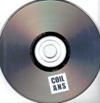
In addition to some suitably odd printed art cards and scrying mirrors,every live box set also includes a black plastic clamshell containingthis, a tour-only CD available at some of Coil's most recent shows. ANScontains three long tracks of about 20 minutes each, consisting solelyof tones made with the Russian ANS synthesizer. Invented by EugenyMurzin in 1938, only one ANS synthesizer has ever actually been built,and it sits neglected and obscure, collecting dust in the basement ofMoscow State University since 1958. Coil were given access toexperiment and record with the strange machine, and their experimentsare chronicled on this disc. ANS is a "photoelectric" instrument thatproduces music via a completely unique process. The user must inscribea series of line drawings that represent visible sound waves onto aseries of glass discs. The shape, location and nature of the drawingsdetermines the sound that the synthesizer produces, which encompassesthe entire range of audible sound, 720 pure tones. Unfortunately, thefascinating history and musical theory behind the ANS instrument isultimately far more interesting than the music Coil has managed to makewith it. While there are many dramatic points of convergence buriedwithin these abstract, long-form compositions, the overall effect is ofdilettantes noodling around with an unfamiliar piece of equipment thatreportedly takes years to properly master. Though there are some partsof ANS that are reminiscent of Time Machines, none of thesepieces has the trance-inducing intensity of that album's minimalistdrones. Reportedly, Coil are remixing and expanding ANS into anofficial double album release scheduled for later this year. Perhapswith a bit of the signature Coil touch added to these naked tones, thismaterial will come alive. As it stands, ANS is a fascinating but musically non-compelling tangent into the avant-garde realm of theoretical music.
samples:
 MEGALITHOMANIA!
MEGALITHOMANIA!With each box set, Coil includes a CD-R of their performance at theMegalithomania! Festival. This disc cannot be purchased separately, andis available only as part of the limited edition box. It's a very nicebonus indeed, as this performance is unique among Coil's live history,and marks a sort of turning point for the group. Megalithomania!was a celebration of sacred sites and standing stones as expressedthrough history, folklore, art and sound. Basically, everything thatJulian Cope was on about in his mammoth tome "The Modern Antiquarian."For this special event, Coil performed a long, drawn-out permutation on"The Universe is a Haunted House," turning the piece into a slowlyevolving ambient sound sculpture involving the ghostly sound of waterdroplets, quietly droning synths, and a particularly spectral vocalimprovisation from Balance. As reported by many people who attended theevent, there seemed to be a strange rift between Balance and Sleazy,evidenced by John's agitated screaming: "Why are you here? Why are youhere?" Balance's statement that "we are the alien" could be read as atribute to the extra-terrestrial builders of Stonehenge, or as afurther statement of his growing alienation from his long-time partner.A few days after this performance, Peter and John announced that whileCoil would continue, they would no longer describe themselves as acouple. Sad, indeed, but these personal matters cannot overshadow avery unique and powerful performance. As the tension and mutationcompounds over the 40-minute length, Balance's alien incantations fightfor prominence with Thighpaulsandra's thick slabs of stoned-Druidsynthesizer. The recording is spotless, highlighting all of the ghostlyminutiae of this one-of-a-kind Coil show.
samples:



